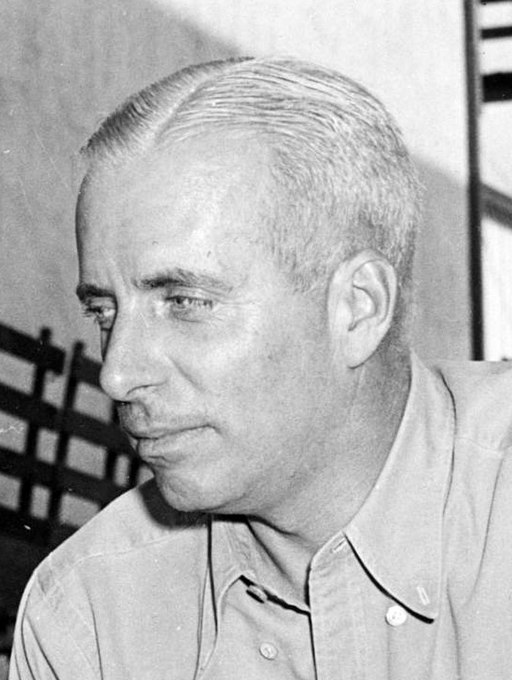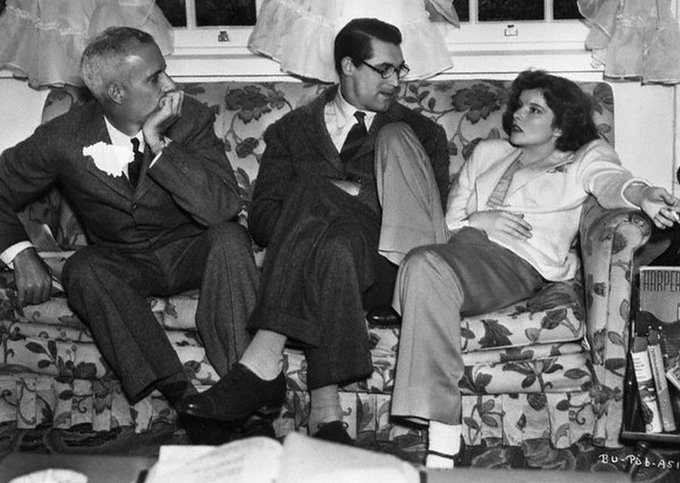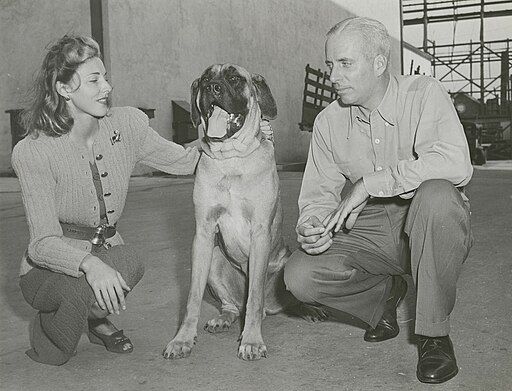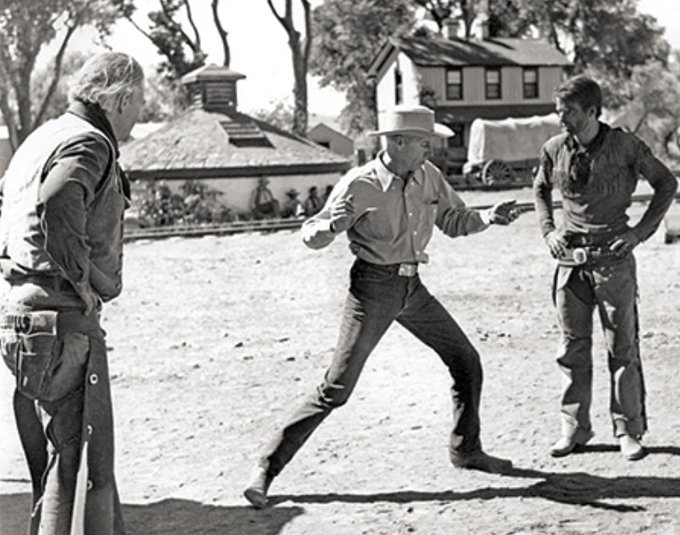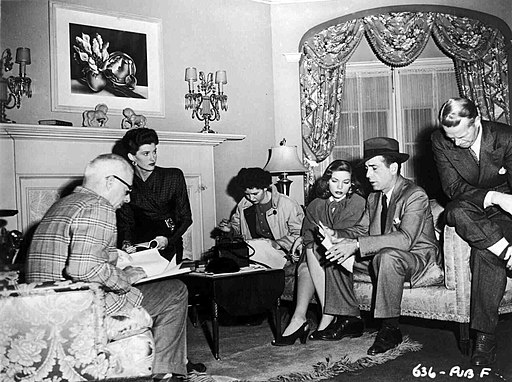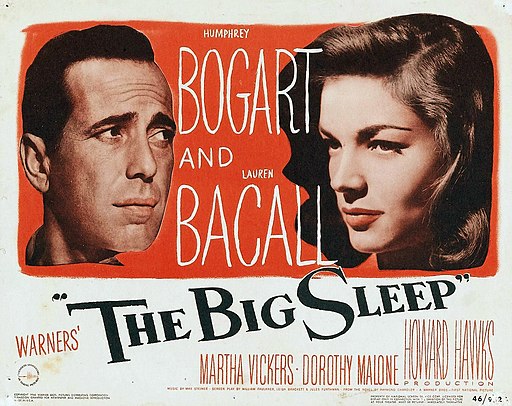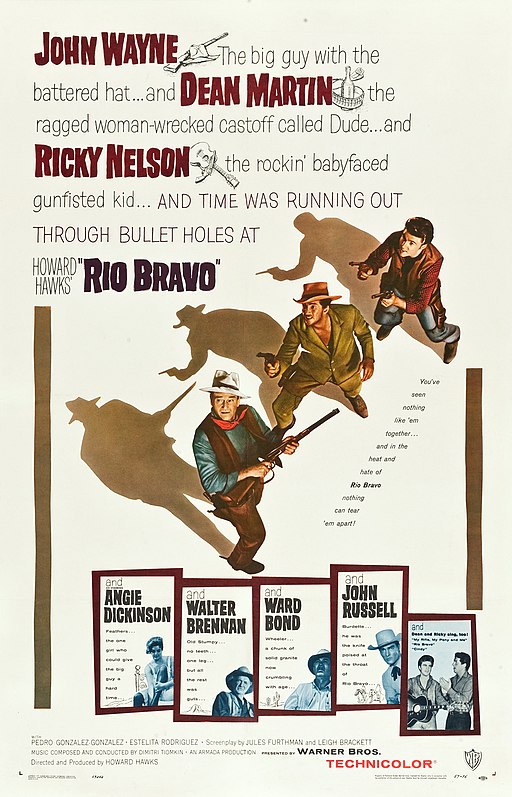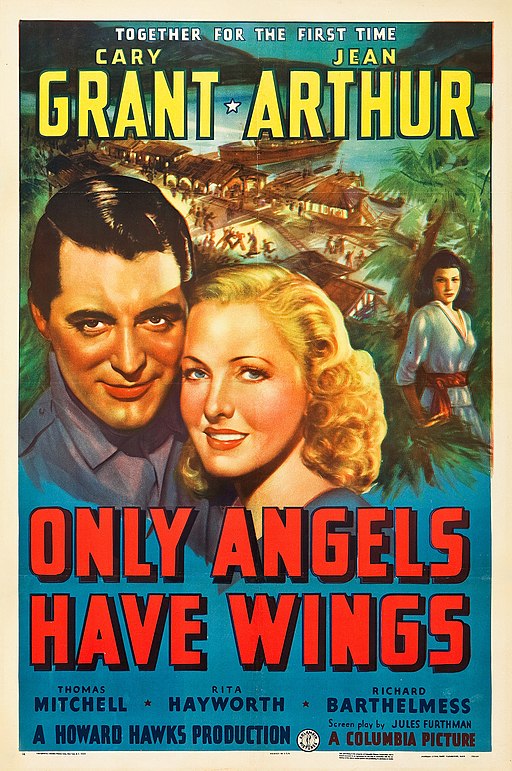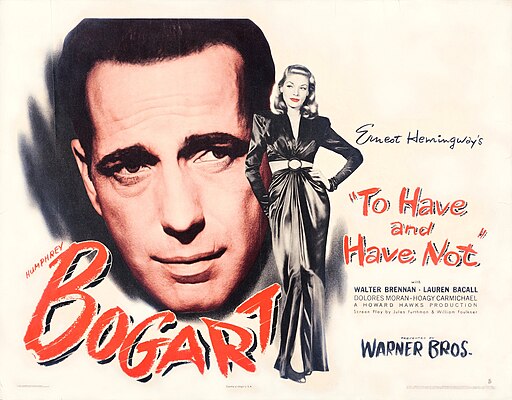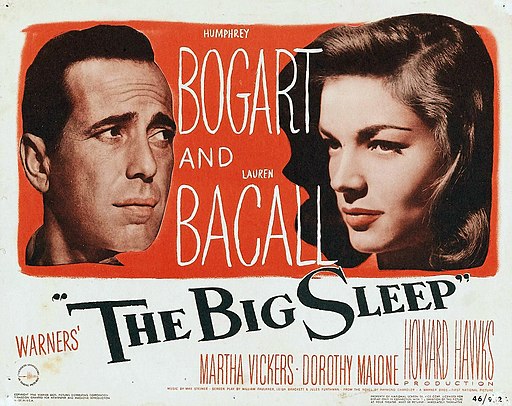Howard Hawks
back| Full Name | Howard Winchester Hawks |
| Born | May 30, 1896 |
| Birthplace | Goshen, Indiana, USA |
| Died | December 26, 1977 |
| Buried | Howard Hawks was cremated, and his ashes were scattered in the desert near Calimesa, California |
| Married to | Athole Shearer (1928–1940) - Nancy Gross (1941–1974) - Dee Hartford (1953–1959) - Gigi Parrish (1977 until his death) |
| Children | Barbara Hawks - Gerald Hawks - Kathleen Hawks |
| Notable films | Scarface (1932) - Bringing Up Baby (1938) - His Girl Friday (1940) - To Have and Have Not (1944) - The Big Sleep (1946) - Red River (1948) - Gentlemen Prefer Blondes (1953) |
Howard Hawks
The Silver Fox of Hollywood
Howard Hawks was an iconic American film director and producer, renowned for his versatility across multiple genres, including screwball comedies, crime films, and westerns.
Notable films include the gangster classic "Scarface" (1932), the screwball comedy "His Girl Friday" (1940), and the western "Red River" (1948). Despite a career spanning over four decades and creating many influential films, Hawks was only nominated once for an Academy Award for Best Director and received an honorary Oscar in 1975.
Related
Howard Hawks (1896 - 1977)
Biography and Overview of his Career
Howard Winchester Hawks was born on May 30, 1896, in Goshen, Indiana. His family soon moved to Pasadena, California, which played a pivotal role in shaping his early years. Young Hawks was raised in a prosperous environment, which afforded him the luxury of quality education and exposure to diverse experiences. He attended the prestigious Phillips Exeter Academy and later pursued mechanical engineering at Cornell University. His Cornell years were instrumental in fostering his lifelong interest in aviation, a theme that would later permeate several of his films.
Career Beginnings
After serving as a flight instructor in the U.S. Army Air Corps during World War I, Hawks ventured into the burgeoning film industry. His journey began modestly in the prop departments of studios, but his talent and determination quickly escalated his career. He transitioned into scriptwriting and then into directing, a role in which he would leave an indelible mark on Hollywood.
Hollywood Career
Hawks' directorial debut came in the silent film era, but it was in the talkies where he truly flourished. He directed a string of successful and genre-defining films. Notable among them are "Scarface" (1932), a groundbreaking gangster film; "Bringing Up Baby" (1938) and "His Girl Friday" (1940), which are considered quintessential screwball comedies; and "The Big Sleep" (1946), a film noir classic. His work in "Red River" (1948) and "Rio Bravo" (1959) redefined the western genre. Hawks was known for his versatility, a rare trait that allowed him to excel across genres.
His films were marked by a distinctive style – an emphasis on rapid-fire, witty dialogues, complex but coherent narratives, and a focus on professional characters who are competent and cool under pressure. This "Hawksian" style would be emulated and admired by generations of filmmakers.
Personal Life
Hawks' personal life was as eventful as his films. He married four times, with each marriage reflecting a different phase of his life. His spouses included Athole Shearer, Nancy Gross, Dee Hartford, and finally, Gigi Parrish. He had three children – Barbara, Gerald, and Kathleen. Hawks' personal relationships, especially with his actors, were often intense and productive, contributing significantly to the success of his films.
Legacy and Death
Despite his monumental contributions to cinema, Hawks was often overlooked by the Academy during his active years, receiving only an honorary Oscar in 1975. He passed away on December 26, 1977, leaving behind a rich legacy that has only grown with time. Hawks' influence extends far beyond the awards; it lies in the enduring appeal of his films and the way he shaped cinematic narratives and character archetypes.
Howard Hawks was often referred to as "The Silver Fox" of Hollywood, a nickname that reflected both his distinguished appearance and his cunning, intelligent approach to filmmaking.
A Conversation with Howard Hawks:
Analysis of Howard Hawks’ Directing Style:
Howard Hawks, renowned for his versatility and mastery across various genres, had a distinct directing style that made him one of the most respected and influential directors in Hollywood. These are the key aspects of his directing style:
Genre Versatility
Hawks was unique in his ability to excel in multiple genres, including comedies, dramas, gangster films, westerns, and adventure films. This versatility was not common among his contemporaries, who often specialized in specific genres. Despite the genre, his films consistently showcased a deep understanding of storytelling and character development.
Characterization and Themes
Hawks often focused on themes of professionalism and male camaraderie. His characters were typically competent, professional, and cool under pressure. They often displayed a sense of stoicism and an unwavering moral code. This is evident in films like "Only Angels Have Wings" and "Rio Bravo". Additionally, Hawks' female characters were strong, intelligent, and equally matched with their male counterparts, seen in films like "His Girl Friday" and "The Big Sleep".
Dialogue and Interaction
A defining feature of Hawks' films was the rapid-fire, overlapping dialogue, which created a dynamic and realistic interaction among characters. This technique, especially prominent in his comedies, added a layer of energy and wit to the narrative. The fast-paced dialogues in "His Girl Friday" are a prime example, showcasing Hawks’ ability to craft dialogue that was both natural and dramatically effective.
Cinematic Techniques
Hawks preferred a straightforward and unobtrusive style in cinematography and editing. He avoided overly stylized shots, believing that flashy techniques could detract from the story and characters. His focus was always on making the narrative and characters engaging, rather than relying on visual gimmicks. This approach is evident in "Red River" and "The Big Sleep", where the storytelling takes precedence.
Collaborations and Actor Direction
Hawks was known for his fruitful collaborations with major stars like Cary Grant, John Wayne, and Humphrey Bogart. He had a talent for bringing out the best in actors, often allowing them to improvise and contribute to their characters. This collaboration resulted in memorable performances that were both authentic and engaging.
Legacy
Hawks' influence extends beyond his films; he impacted the way directors approached character development, dialogue, and genre. His style influenced future generations of filmmakers, and his works are studied for their narrative structure and character interplay.
In summary, Howard Hawks’ directing style was marked by a focus on strong, professional characters, rapid and witty dialogue, and a masterful handling of various genres. His unobtrusive cinematic techniques and collaborative approach with actors resulted in films that were not only entertaining but also influential in the evolution of Hollywood cinema.
Memorable Quotes from Howard Hawks:
On Storytelling:
- "A good movie is three good scenes and no bad scenes."
- "A story should have a beginning, a middle, and an end… but not necessarily in that order."
On Film Direction:
- "A director is someone who presides over accidents."
- "I'm a storyteller - that's the chief function of a director. And they're moving pictures, let's make 'em move!"
On Characters:
- "There's action only if there is danger."
On Comedy:
- "I've always been partial to comedies, because I like to laugh."
On His Approach:
- "I never made a message picture, and I never made a picture for any reason but that it interested me."
On Professionalism:
- "I love the idea of the professionalism of doing your job well, whatever your job happens to be."
On Making Movies:
- "Making movies is just like betting on horses. It's a gamble every time."
On Film Casting:
- "Casting is 65 percent of directing."
On Audience Engagement:
- "What's important is that a movie doesn't look like a movie. It looks like life. The audience doesn't think, they feel."
Significance of the movie “Scarface” for his Career:
"Scarface," directed by Howard Hawks in 1932, played a pivotal role in his career and left a lasting impact on the film industry for several reasons:
- Genre Defining: "Scarface" is considered one of the earliest and most influential films in the gangster genre. Its portrayal of the rise and fall of a criminal overlord set a template for countless gangster films that followed.
- Stylistic Influence: The film showcased Hawks' signature directing style, especially his use of rapid-fire dialogue and his focus on morally complex characters. These elements would become hallmarks of his later works.
- Controversy and Publicity: The film's controversial subject matter, which included explicit violence and a critical portrayal of the American dream, generated significant public and censorship attention. This controversy, while initially a challenge (it faced censorship battles and delays in release), ultimately heightened the film's profile and, by extension, Hawks' reputation.
- Critical Acclaim: Despite the initial controversies, "Scarface" was critically acclaimed for its bold storytelling and technical innovation, solidifying Hawks' status as a prominent director in Hollywood.
- Influence on Filmmaking: Hawks' handling of thematic elements like crime, morality, and the corrupting influence of power in "Scarface" influenced the narrative and stylistic approaches of future filmmakers in the crime and noir genres.
Howard Hawks and Ben Hecht:
Howard Hawks and Ben Hecht had a significant professional relationship in the realm of cinema. Ben Hecht was an acclaimed screenwriter, playwright, and novelist, known for his ability to craft compelling stories and dialogues. Their collaboration is most famously noted in the making of the film "Scarface" (1932), a groundbreaking gangster film that Hecht wrote and Hawks directed.
Hecht's sharp, fast-paced writing style meshed well with Hawks' directorial approach, which favored quick-witted dialogue and tight narrative structures. In "Scarface," this collaboration resulted in a film that was both controversial for its time, due to its violent content and candid portrayal of gangster life, and acclaimed for its artistry and influence on the crime genre.
Their partnership is a prime example of how writer-director collaborations in Hollywood can produce seminal works that leave lasting impacts on the film industry. The success of "Scarface" helped cement both Hawks' and Hecht's reputations in their respective fields.
Awards and Recognition:
Howard Hawks, despite his significant impact on cinema, had a surprisingly limited history with awards and nominations, particularly when it comes to the Academy Awards. Here's an overview of his most notable recognitions:
Academy Awards
- 1942: Hawks was nominated for the Academy Award for Best Director for "Sergeant York." This World War I drama was also nominated for Best Picture and won two Oscars, though Hawks did not personally win.
- 1975: He received an Honorary Academy Award. The citation for this award recognized his "distinguished career in the motion picture industry."
Venice Film Festival
- 1932: His film "Scarface" was nominated for the Mussolini Cup for Best Foreign Film at the Venice Film Festival. This was a significant achievement at the time, given the film's controversial subject matter.
Other Honors and Recognitions
Although Hawks did not amass a large collection of awards during his career, his influence and contributions have been widely acknowledged by film historians, critics, and contemporary filmmakers. Some posthumous recognitions include:
- 1998: Hawks was included in the list of the "Greatest Directors" by the British Film Institute (BFI) Sight & Sound poll.
- Directors Guild of America (DGA): Hawks has been honored posthumously by the DGA for his lifetime contributions to American cinema.
- Various Film Critic Circles and Societies: Over the years, numerous film critics' circles and societies have retrospectively acknowledged Hawks' contributions to cinema, often listing his films among the greatest ever made.
Movies Directed by Howard Hawks:
1920s
- 1926: "The Road to Glory": A romantic drama set against the backdrop of World War I, focusing on the lives and loves of soldiers.
- 1927: "Paid to Love": A comedy about an American banker trying to modernize a Balkan state.
- 1928: "A Girl in Every Port": This comedy tells the story of two sailors and their numerous romantic escapades.
- 1928: "Fazil": An exotic romance set in the desert, featuring a prince who falls for a European woman.
- 1928: "The Air Circus": A silent drama about two young men attending a flight school.
1930s
- 1930: "The Dawn Patrol": Focusing on British World War I pilots, this film explores the camaraderie and struggles they face.
- 1931: "The Criminal Code": A prison drama about a district attorney who becomes a warden and faces moral dilemmas.
- 1932: "Scarface": A landmark gangster film, it follows the rise and fall of a Chicago mobster.
- 1932: "The Crowd Roars": A drama about the personal and professional challenges faced by a racecar driver.
- 1933: "Today We Live": A romantic war drama set during World War I.
- 1934: "Twentieth Century": A screwball comedy about a Broadway producer and his tumultuous relationship with a star actress.
- 1935: "Barbary Coast": Set during the California Gold Rush, this film mixes romance and adventure.
- 1936: "The Road to Glory": A remake of his 1926 film, focusing on French soldiers in World War I.
- 1936: "Ceiling Zero": An aviation drama about the lives of mail pilots and the risks they take.
- 1938: "Bringing Up Baby": A classic screwball comedy starring Katharine Hepburn and Cary Grant.
- 1939: "Only Angels Have Wings": A drama about mail pilots in South America and their dangerous lives.
1940s
- 1940: "His Girl Friday": A fast-paced comedy about a newspaper editor trying to keep his ex-wife and star reporter from remarrying.
- 1941: "Sergeant York": Biographical film about World War I hero Alvin C. York.
- 1941: "Ball of Fire": A screwball comedy about a group of professors writing an encyclopedia and a nightclub singer.
- 1943: "Air Force": A World War II film following the crew of the Mary-Ann, a B-17 bomber.
- 1944: "To Have and Have Not": A romantic adventure set in World War II, marking the first pairing of Humphrey Bogart and Lauren Bacall.
- 1946: "The Big Sleep": A film noir based on Raymond Chandler's novel, again starring Bogart and Bacall.
- 1948: "Red River": A western epic about a cattle drive and the conflict between a tyrannical rancher and his adopted son.
- 1949: "I Was a Male War Bride": A comedy about a French army officer who marries an American WAC.
1950s
- 1951: "The Thing from Another World": A science fiction horror film about an alien discovered in the Arctic.
- 1952: "The Big Sky": A western about the journey of two men on the Missouri River.
- 1952: "Monkey Business": A screwball comedy about a chemist who discovers a rejuvenating potion.
- 1953: "Gentlemen Prefer Blondes": A musical comedy famous for Marilyn Monroe's performance.
- 1955: "Land of the Pharaohs": A historical epic about the building of the Great Pyramid of Khufu.
- 1959: "Rio Bravo": A western starring John Wayne, revolving around a small-town sheriff in a standoff against a local criminal gang.
1960s
- 1962: "Hatari!": An adventure comedy about a group of professional game catchers in Africa.
- 1964: "Man's Favorite Sport?": A romantic comedy about a fishing expert who actually knows nothing about fishing.
- 1965: "Red Line 7000": A drama centered around the lives of stock car racers.
- 1966: "El Dorado": A western starring John Wayne and Robert Mitchum, about a gunslinger who helps his drunken friend defend a ranch from a land grabber.
1970s
- 1970: "Rio Lobo": Another western starring John Wayne, about a Civil War veteran tracking down traitors.

